Nursing Care Report: Karam's Appendicitis and Communication Challenges
VerifiedAdded on 2021/02/19
|10
|3190
|61
Report
AI Summary
This report provides a detailed analysis of a nursing care case study involving a 7-year-old boy named Karam who underwent a laparoscopic appendicectomy for appendicitis. The report focuses on specific aspects of nursing care, including pain management, the impact of nursing approaches on the child's developmental stage, and the incorporation of child-centered care principles. It addresses the communication challenges arising from a language barrier between the child's family and healthcare professionals, and explores effective strategies to overcome these issues, emphasizing family-centered care principles. The report examines the importance of understanding a child's cognitive abilities, emotional needs, and parental involvement in providing optimal care, and highlights the significance of clear and effective communication in ensuring positive patient outcomes. Furthermore, the report discusses the impact of the surgery on the child's development and growth and stresses the importance of post-operative care and pain management strategies.
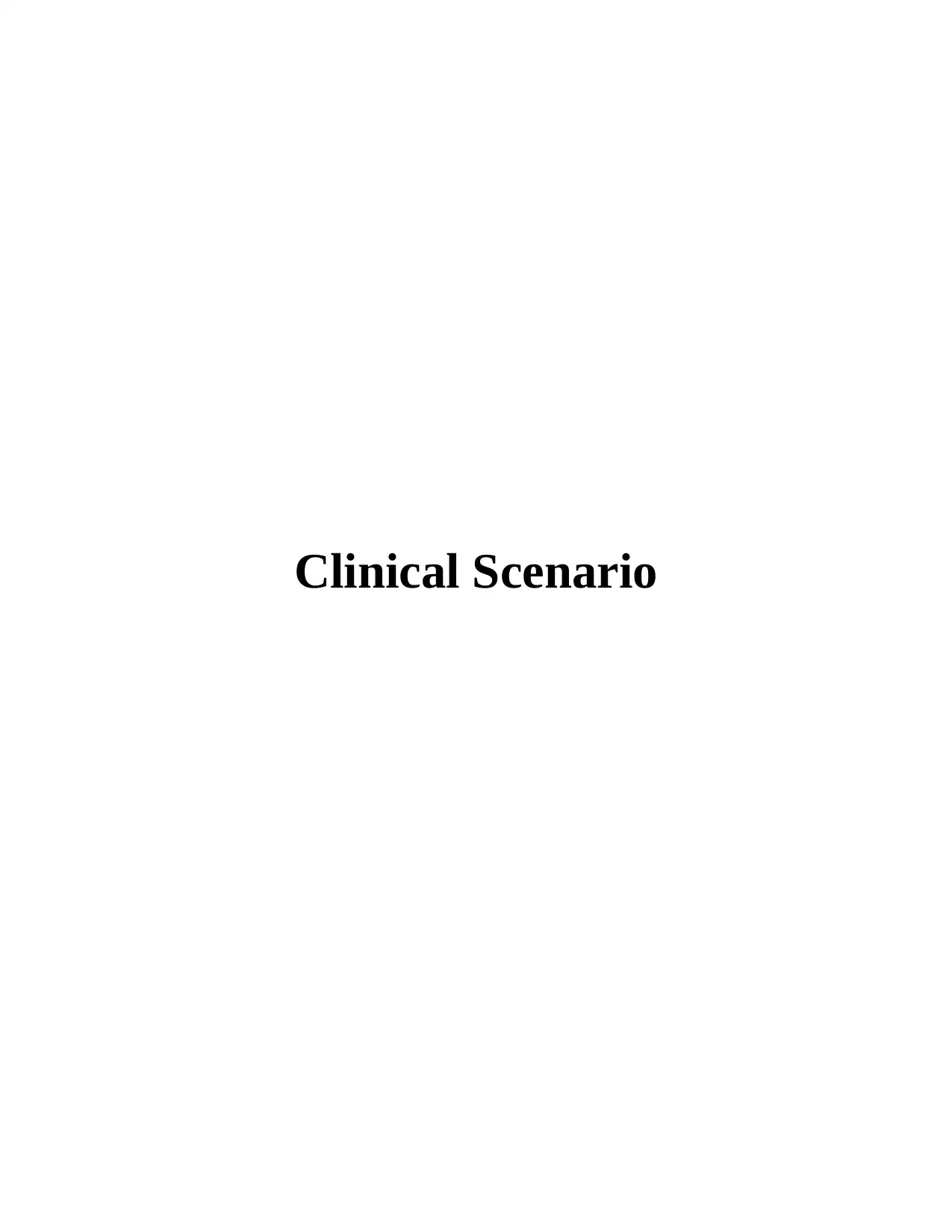
Clinical Scenario
Paraphrase This Document
Need a fresh take? Get an instant paraphrase of this document with our AI Paraphraser
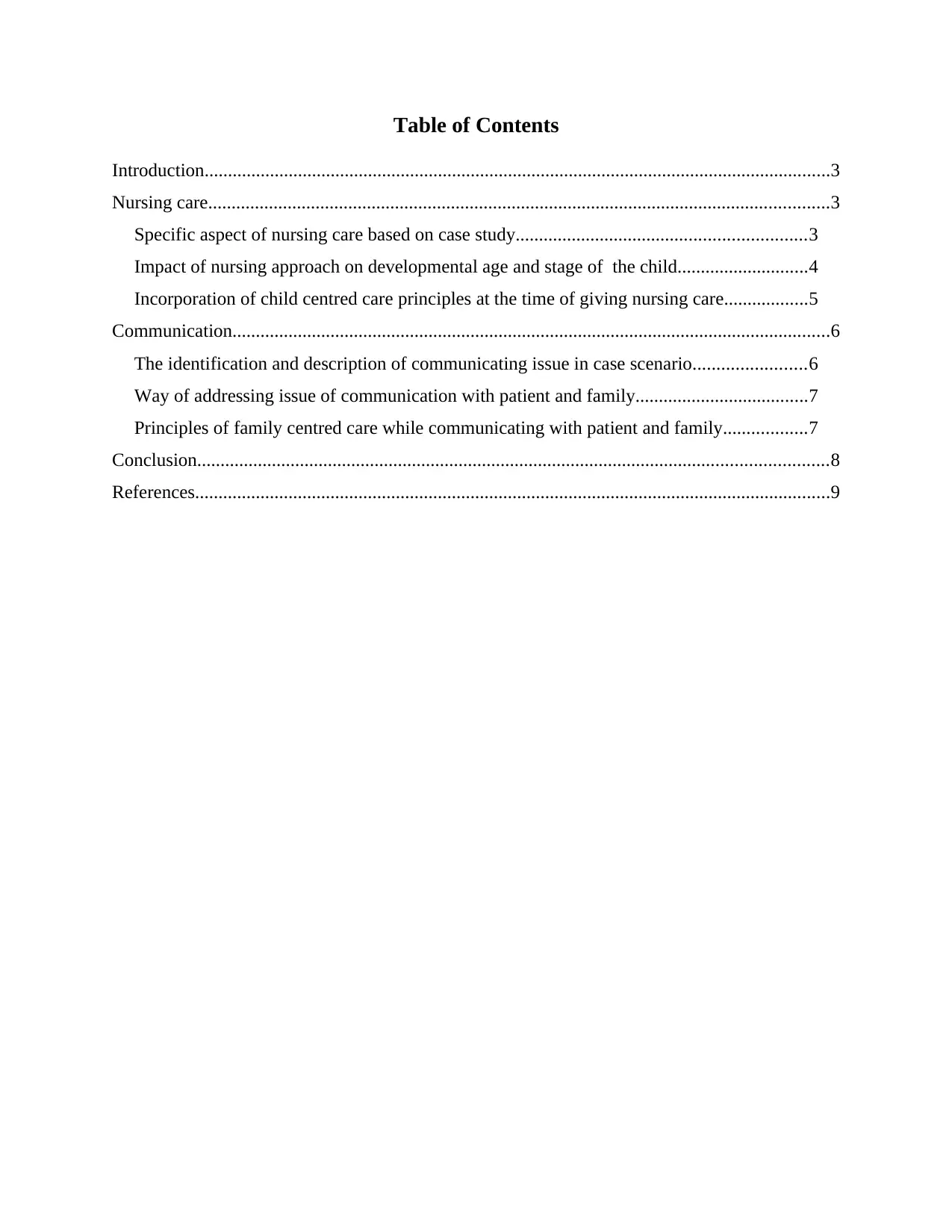
Table of Contents
Introduction......................................................................................................................................3
Nursing care.....................................................................................................................................3
Specific aspect of nursing care based on case study..............................................................3
Impact of nursing approach on developmental age and stage of the child............................4
Incorporation of child centred care principles at the time of giving nursing care..................5
Communication................................................................................................................................6
The identification and description of communicating issue in case scenario........................6
Way of addressing issue of communication with patient and family.....................................7
Principles of family centred care while communicating with patient and family..................7
Conclusion.......................................................................................................................................8
References........................................................................................................................................9
Introduction......................................................................................................................................3
Nursing care.....................................................................................................................................3
Specific aspect of nursing care based on case study..............................................................3
Impact of nursing approach on developmental age and stage of the child............................4
Incorporation of child centred care principles at the time of giving nursing care..................5
Communication................................................................................................................................6
The identification and description of communicating issue in case scenario........................6
Way of addressing issue of communication with patient and family.....................................7
Principles of family centred care while communicating with patient and family..................7
Conclusion.......................................................................................................................................8
References........................................................................................................................................9
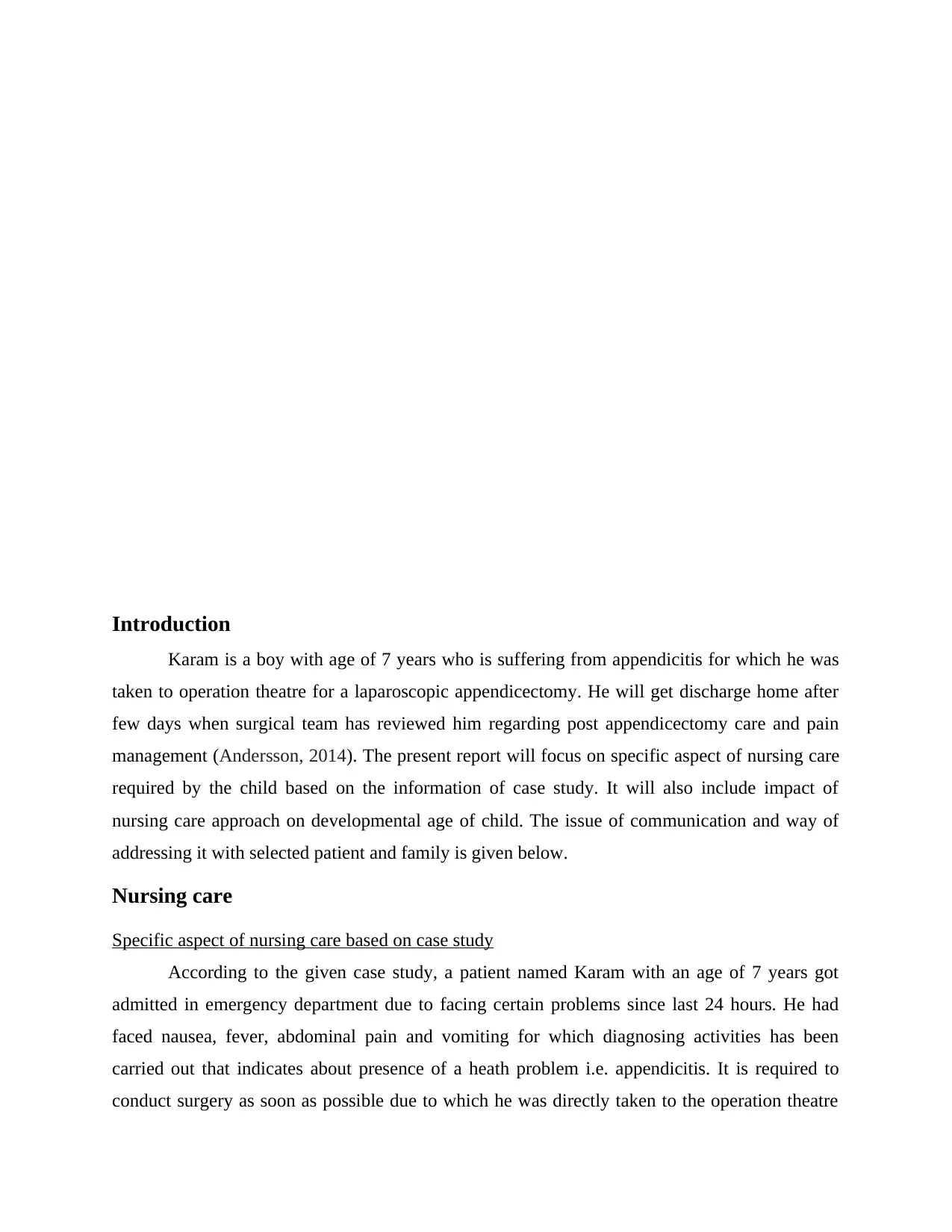
Introduction
Karam is a boy with age of 7 years who is suffering from appendicitis for which he was
taken to operation theatre for a laparoscopic appendicectomy. He will get discharge home after
few days when surgical team has reviewed him regarding post appendicectomy care and pain
management (Andersson, 2014). The present report will focus on specific aspect of nursing care
required by the child based on the information of case study. It will also include impact of
nursing care approach on developmental age of child. The issue of communication and way of
addressing it with selected patient and family is given below.
Nursing care
Specific aspect of nursing care based on case study
According to the given case study, a patient named Karam with an age of 7 years got
admitted in emergency department due to facing certain problems since last 24 hours. He had
faced nausea, fever, abdominal pain and vomiting for which diagnosing activities has been
carried out that indicates about presence of a heath problem i.e. appendicitis. It is required to
conduct surgery as soon as possible due to which he was directly taken to the operation theatre
Karam is a boy with age of 7 years who is suffering from appendicitis for which he was
taken to operation theatre for a laparoscopic appendicectomy. He will get discharge home after
few days when surgical team has reviewed him regarding post appendicectomy care and pain
management (Andersson, 2014). The present report will focus on specific aspect of nursing care
required by the child based on the information of case study. It will also include impact of
nursing care approach on developmental age of child. The issue of communication and way of
addressing it with selected patient and family is given below.
Nursing care
Specific aspect of nursing care based on case study
According to the given case study, a patient named Karam with an age of 7 years got
admitted in emergency department due to facing certain problems since last 24 hours. He had
faced nausea, fever, abdominal pain and vomiting for which diagnosing activities has been
carried out that indicates about presence of a heath problem i.e. appendicitis. It is required to
conduct surgery as soon as possible due to which he was directly taken to the operation theatre
⊘ This is a preview!⊘
Do you want full access?
Subscribe today to unlock all pages.

Trusted by 1+ million students worldwide
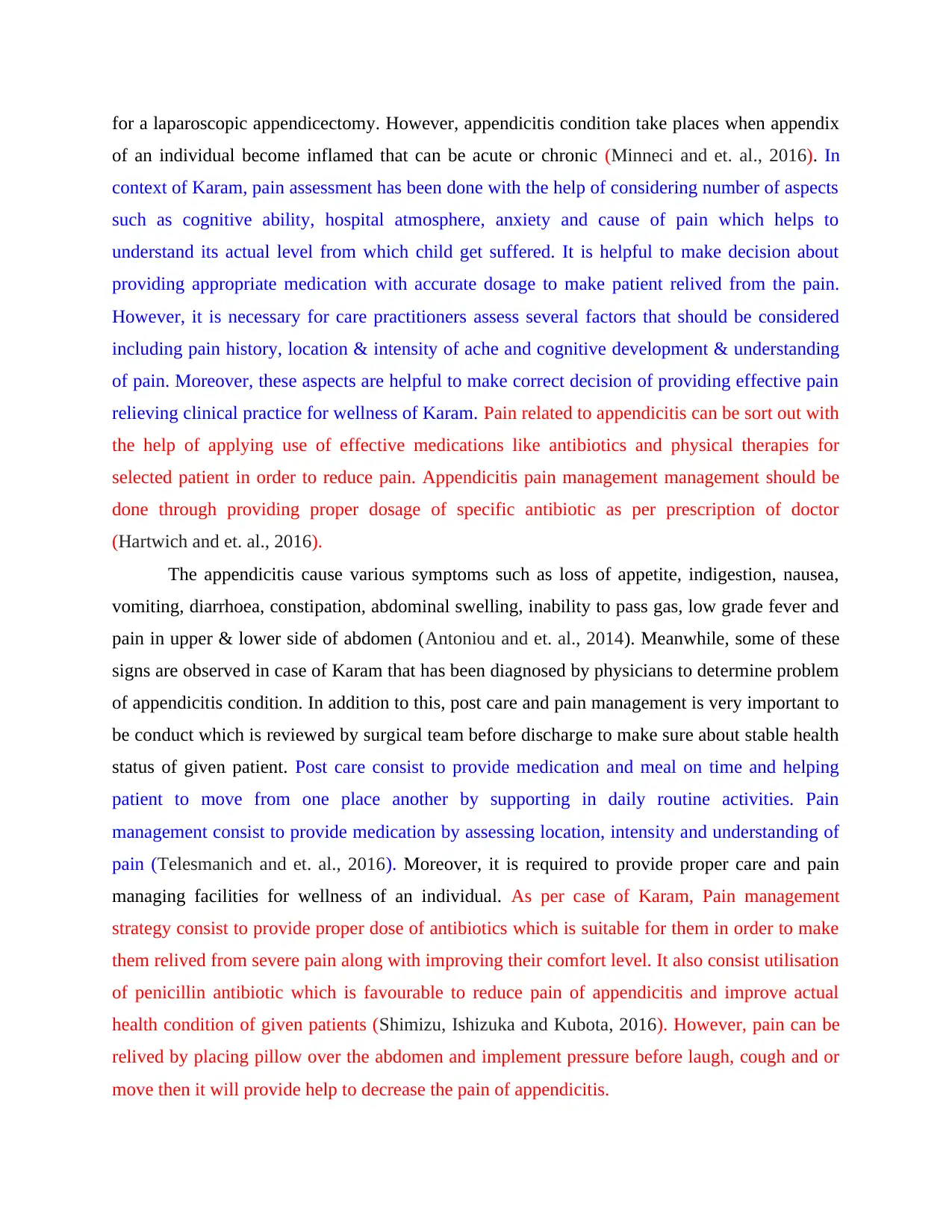
for a laparoscopic appendicectomy. However, appendicitis condition take places when appendix
of an individual become inflamed that can be acute or chronic (Minneci and et. al., 2016). In
context of Karam, pain assessment has been done with the help of considering number of aspects
such as cognitive ability, hospital atmosphere, anxiety and cause of pain which helps to
understand its actual level from which child get suffered. It is helpful to make decision about
providing appropriate medication with accurate dosage to make patient relived from the pain.
However, it is necessary for care practitioners assess several factors that should be considered
including pain history, location & intensity of ache and cognitive development & understanding
of pain. Moreover, these aspects are helpful to make correct decision of providing effective pain
relieving clinical practice for wellness of Karam. Pain related to appendicitis can be sort out with
the help of applying use of effective medications like antibiotics and physical therapies for
selected patient in order to reduce pain. Appendicitis pain management management should be
done through providing proper dosage of specific antibiotic as per prescription of doctor
(Hartwich and et. al., 2016).
The appendicitis cause various symptoms such as loss of appetite, indigestion, nausea,
vomiting, diarrhoea, constipation, abdominal swelling, inability to pass gas, low grade fever and
pain in upper & lower side of abdomen (Antoniou and et. al., 2014). Meanwhile, some of these
signs are observed in case of Karam that has been diagnosed by physicians to determine problem
of appendicitis condition. In addition to this, post care and pain management is very important to
be conduct which is reviewed by surgical team before discharge to make sure about stable health
status of given patient. Post care consist to provide medication and meal on time and helping
patient to move from one place another by supporting in daily routine activities. Pain
management consist to provide medication by assessing location, intensity and understanding of
pain (Telesmanich and et. al., 2016). Moreover, it is required to provide proper care and pain
managing facilities for wellness of an individual. As per case of Karam, Pain management
strategy consist to provide proper dose of antibiotics which is suitable for them in order to make
them relived from severe pain along with improving their comfort level. It also consist utilisation
of penicillin antibiotic which is favourable to reduce pain of appendicitis and improve actual
health condition of given patients (Shimizu, Ishizuka and Kubota, 2016). However, pain can be
relived by placing pillow over the abdomen and implement pressure before laugh, cough and or
move then it will provide help to decrease the pain of appendicitis.
of an individual become inflamed that can be acute or chronic (Minneci and et. al., 2016). In
context of Karam, pain assessment has been done with the help of considering number of aspects
such as cognitive ability, hospital atmosphere, anxiety and cause of pain which helps to
understand its actual level from which child get suffered. It is helpful to make decision about
providing appropriate medication with accurate dosage to make patient relived from the pain.
However, it is necessary for care practitioners assess several factors that should be considered
including pain history, location & intensity of ache and cognitive development & understanding
of pain. Moreover, these aspects are helpful to make correct decision of providing effective pain
relieving clinical practice for wellness of Karam. Pain related to appendicitis can be sort out with
the help of applying use of effective medications like antibiotics and physical therapies for
selected patient in order to reduce pain. Appendicitis pain management management should be
done through providing proper dosage of specific antibiotic as per prescription of doctor
(Hartwich and et. al., 2016).
The appendicitis cause various symptoms such as loss of appetite, indigestion, nausea,
vomiting, diarrhoea, constipation, abdominal swelling, inability to pass gas, low grade fever and
pain in upper & lower side of abdomen (Antoniou and et. al., 2014). Meanwhile, some of these
signs are observed in case of Karam that has been diagnosed by physicians to determine problem
of appendicitis condition. In addition to this, post care and pain management is very important to
be conduct which is reviewed by surgical team before discharge to make sure about stable health
status of given patient. Post care consist to provide medication and meal on time and helping
patient to move from one place another by supporting in daily routine activities. Pain
management consist to provide medication by assessing location, intensity and understanding of
pain (Telesmanich and et. al., 2016). Moreover, it is required to provide proper care and pain
managing facilities for wellness of an individual. As per case of Karam, Pain management
strategy consist to provide proper dose of antibiotics which is suitable for them in order to make
them relived from severe pain along with improving their comfort level. It also consist utilisation
of penicillin antibiotic which is favourable to reduce pain of appendicitis and improve actual
health condition of given patients (Shimizu, Ishizuka and Kubota, 2016). However, pain can be
relived by placing pillow over the abdomen and implement pressure before laugh, cough and or
move then it will provide help to decrease the pain of appendicitis.
Paraphrase This Document
Need a fresh take? Get an instant paraphrase of this document with our AI Paraphraser
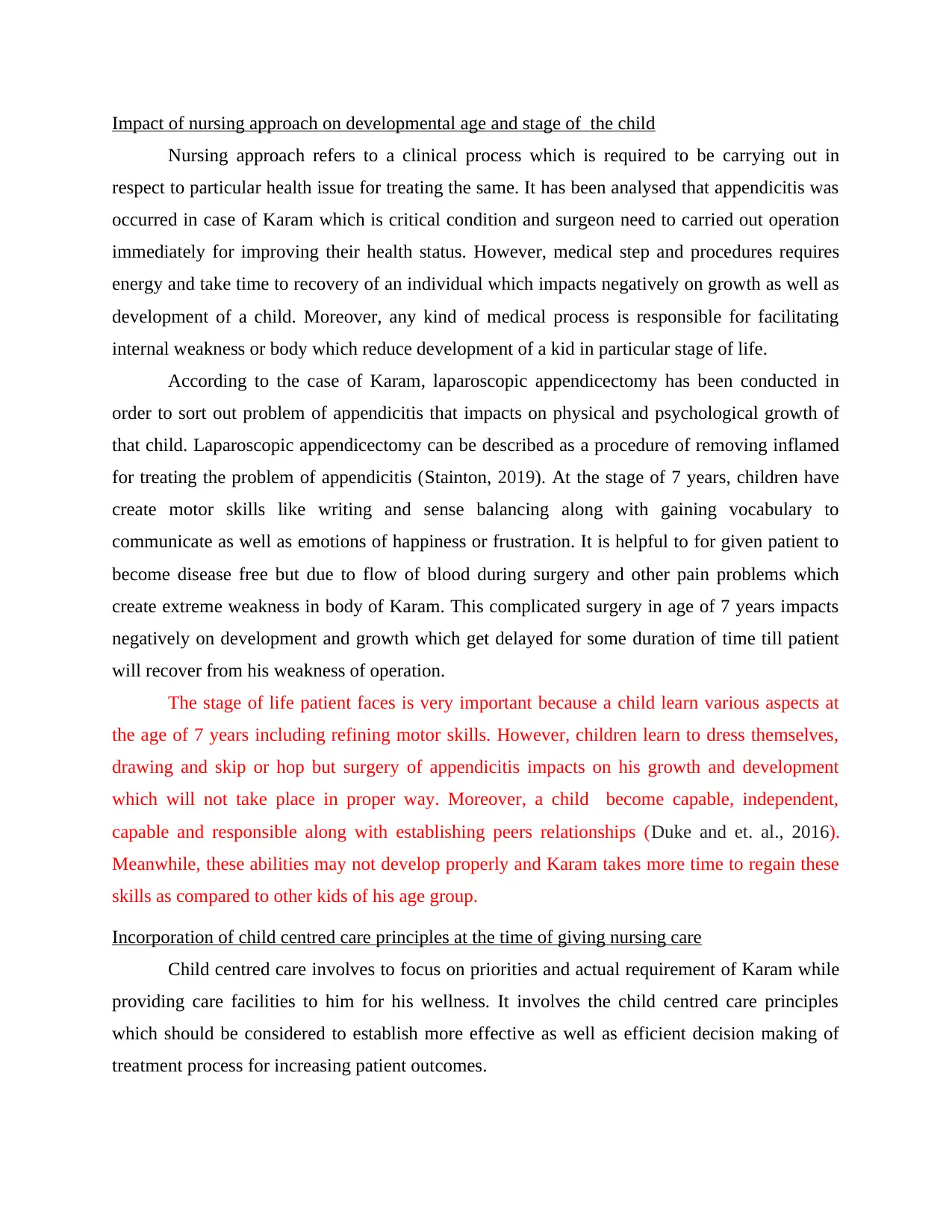
Impact of nursing approach on developmental age and stage of the child
Nursing approach refers to a clinical process which is required to be carrying out in
respect to particular health issue for treating the same. It has been analysed that appendicitis was
occurred in case of Karam which is critical condition and surgeon need to carried out operation
immediately for improving their health status. However, medical step and procedures requires
energy and take time to recovery of an individual which impacts negatively on growth as well as
development of a child. Moreover, any kind of medical process is responsible for facilitating
internal weakness or body which reduce development of a kid in particular stage of life.
According to the case of Karam, laparoscopic appendicectomy has been conducted in
order to sort out problem of appendicitis that impacts on physical and psychological growth of
that child. Laparoscopic appendicectomy can be described as a procedure of removing inflamed
for treating the problem of appendicitis (Stainton, 2019). At the stage of 7 years, children have
create motor skills like writing and sense balancing along with gaining vocabulary to
communicate as well as emotions of happiness or frustration. It is helpful to for given patient to
become disease free but due to flow of blood during surgery and other pain problems which
create extreme weakness in body of Karam. This complicated surgery in age of 7 years impacts
negatively on development and growth which get delayed for some duration of time till patient
will recover from his weakness of operation.
The stage of life patient faces is very important because a child learn various aspects at
the age of 7 years including refining motor skills. However, children learn to dress themselves,
drawing and skip or hop but surgery of appendicitis impacts on his growth and development
which will not take place in proper way. Moreover, a child become capable, independent,
capable and responsible along with establishing peers relationships (Duke and et. al., 2016).
Meanwhile, these abilities may not develop properly and Karam takes more time to regain these
skills as compared to other kids of his age group.
Incorporation of child centred care principles at the time of giving nursing care
Child centred care involves to focus on priorities and actual requirement of Karam while
providing care facilities to him for his wellness. It involves the child centred care principles
which should be considered to establish more effective as well as efficient decision making of
treatment process for increasing patient outcomes.
Nursing approach refers to a clinical process which is required to be carrying out in
respect to particular health issue for treating the same. It has been analysed that appendicitis was
occurred in case of Karam which is critical condition and surgeon need to carried out operation
immediately for improving their health status. However, medical step and procedures requires
energy and take time to recovery of an individual which impacts negatively on growth as well as
development of a child. Moreover, any kind of medical process is responsible for facilitating
internal weakness or body which reduce development of a kid in particular stage of life.
According to the case of Karam, laparoscopic appendicectomy has been conducted in
order to sort out problem of appendicitis that impacts on physical and psychological growth of
that child. Laparoscopic appendicectomy can be described as a procedure of removing inflamed
for treating the problem of appendicitis (Stainton, 2019). At the stage of 7 years, children have
create motor skills like writing and sense balancing along with gaining vocabulary to
communicate as well as emotions of happiness or frustration. It is helpful to for given patient to
become disease free but due to flow of blood during surgery and other pain problems which
create extreme weakness in body of Karam. This complicated surgery in age of 7 years impacts
negatively on development and growth which get delayed for some duration of time till patient
will recover from his weakness of operation.
The stage of life patient faces is very important because a child learn various aspects at
the age of 7 years including refining motor skills. However, children learn to dress themselves,
drawing and skip or hop but surgery of appendicitis impacts on his growth and development
which will not take place in proper way. Moreover, a child become capable, independent,
capable and responsible along with establishing peers relationships (Duke and et. al., 2016).
Meanwhile, these abilities may not develop properly and Karam takes more time to regain these
skills as compared to other kids of his age group.
Incorporation of child centred care principles at the time of giving nursing care
Child centred care involves to focus on priorities and actual requirement of Karam while
providing care facilities to him for his wellness. It involves the child centred care principles
which should be considered to establish more effective as well as efficient decision making of
treatment process for increasing patient outcomes.
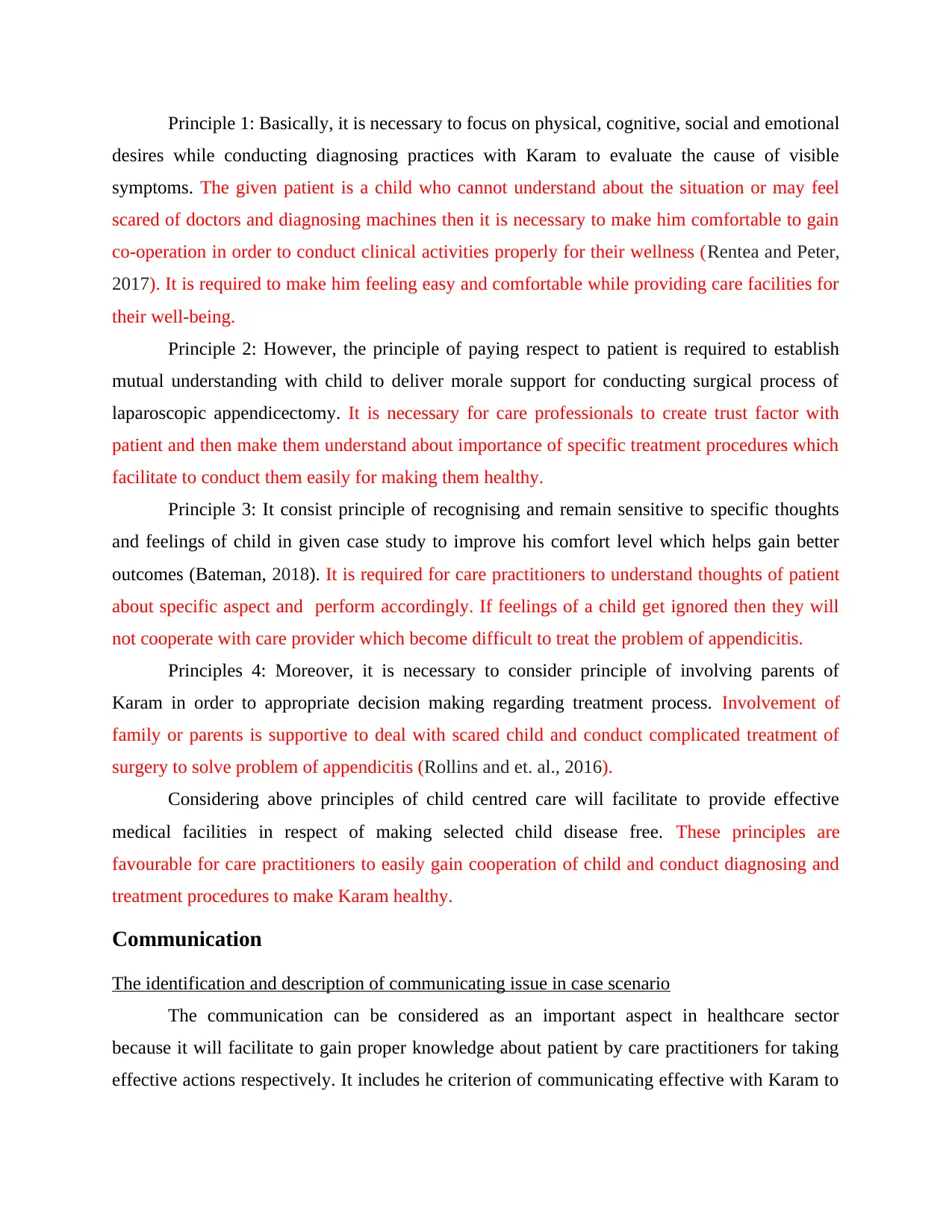
Principle 1: Basically, it is necessary to focus on physical, cognitive, social and emotional
desires while conducting diagnosing practices with Karam to evaluate the cause of visible
symptoms. The given patient is a child who cannot understand about the situation or may feel
scared of doctors and diagnosing machines then it is necessary to make him comfortable to gain
co-operation in order to conduct clinical activities properly for their wellness (Rentea and Peter,
2017). It is required to make him feeling easy and comfortable while providing care facilities for
their well-being.
Principle 2: However, the principle of paying respect to patient is required to establish
mutual understanding with child to deliver morale support for conducting surgical process of
laparoscopic appendicectomy. It is necessary for care professionals to create trust factor with
patient and then make them understand about importance of specific treatment procedures which
facilitate to conduct them easily for making them healthy.
Principle 3: It consist principle of recognising and remain sensitive to specific thoughts
and feelings of child in given case study to improve his comfort level which helps gain better
outcomes (Bateman, 2018). It is required for care practitioners to understand thoughts of patient
about specific aspect and perform accordingly. If feelings of a child get ignored then they will
not cooperate with care provider which become difficult to treat the problem of appendicitis.
Principles 4: Moreover, it is necessary to consider principle of involving parents of
Karam in order to appropriate decision making regarding treatment process. Involvement of
family or parents is supportive to deal with scared child and conduct complicated treatment of
surgery to solve problem of appendicitis (Rollins and et. al., 2016).
Considering above principles of child centred care will facilitate to provide effective
medical facilities in respect of making selected child disease free. These principles are
favourable for care practitioners to easily gain cooperation of child and conduct diagnosing and
treatment procedures to make Karam healthy.
Communication
The identification and description of communicating issue in case scenario
The communication can be considered as an important aspect in healthcare sector
because it will facilitate to gain proper knowledge about patient by care practitioners for taking
effective actions respectively. It includes he criterion of communicating effective with Karam to
desires while conducting diagnosing practices with Karam to evaluate the cause of visible
symptoms. The given patient is a child who cannot understand about the situation or may feel
scared of doctors and diagnosing machines then it is necessary to make him comfortable to gain
co-operation in order to conduct clinical activities properly for their wellness (Rentea and Peter,
2017). It is required to make him feeling easy and comfortable while providing care facilities for
their well-being.
Principle 2: However, the principle of paying respect to patient is required to establish
mutual understanding with child to deliver morale support for conducting surgical process of
laparoscopic appendicectomy. It is necessary for care professionals to create trust factor with
patient and then make them understand about importance of specific treatment procedures which
facilitate to conduct them easily for making them healthy.
Principle 3: It consist principle of recognising and remain sensitive to specific thoughts
and feelings of child in given case study to improve his comfort level which helps gain better
outcomes (Bateman, 2018). It is required for care practitioners to understand thoughts of patient
about specific aspect and perform accordingly. If feelings of a child get ignored then they will
not cooperate with care provider which become difficult to treat the problem of appendicitis.
Principles 4: Moreover, it is necessary to consider principle of involving parents of
Karam in order to appropriate decision making regarding treatment process. Involvement of
family or parents is supportive to deal with scared child and conduct complicated treatment of
surgery to solve problem of appendicitis (Rollins and et. al., 2016).
Considering above principles of child centred care will facilitate to provide effective
medical facilities in respect of making selected child disease free. These principles are
favourable for care practitioners to easily gain cooperation of child and conduct diagnosing and
treatment procedures to make Karam healthy.
Communication
The identification and description of communicating issue in case scenario
The communication can be considered as an important aspect in healthcare sector
because it will facilitate to gain proper knowledge about patient by care practitioners for taking
effective actions respectively. It includes he criterion of communicating effective with Karam to
⊘ This is a preview!⊘
Do you want full access?
Subscribe today to unlock all pages.

Trusted by 1+ million students worldwide
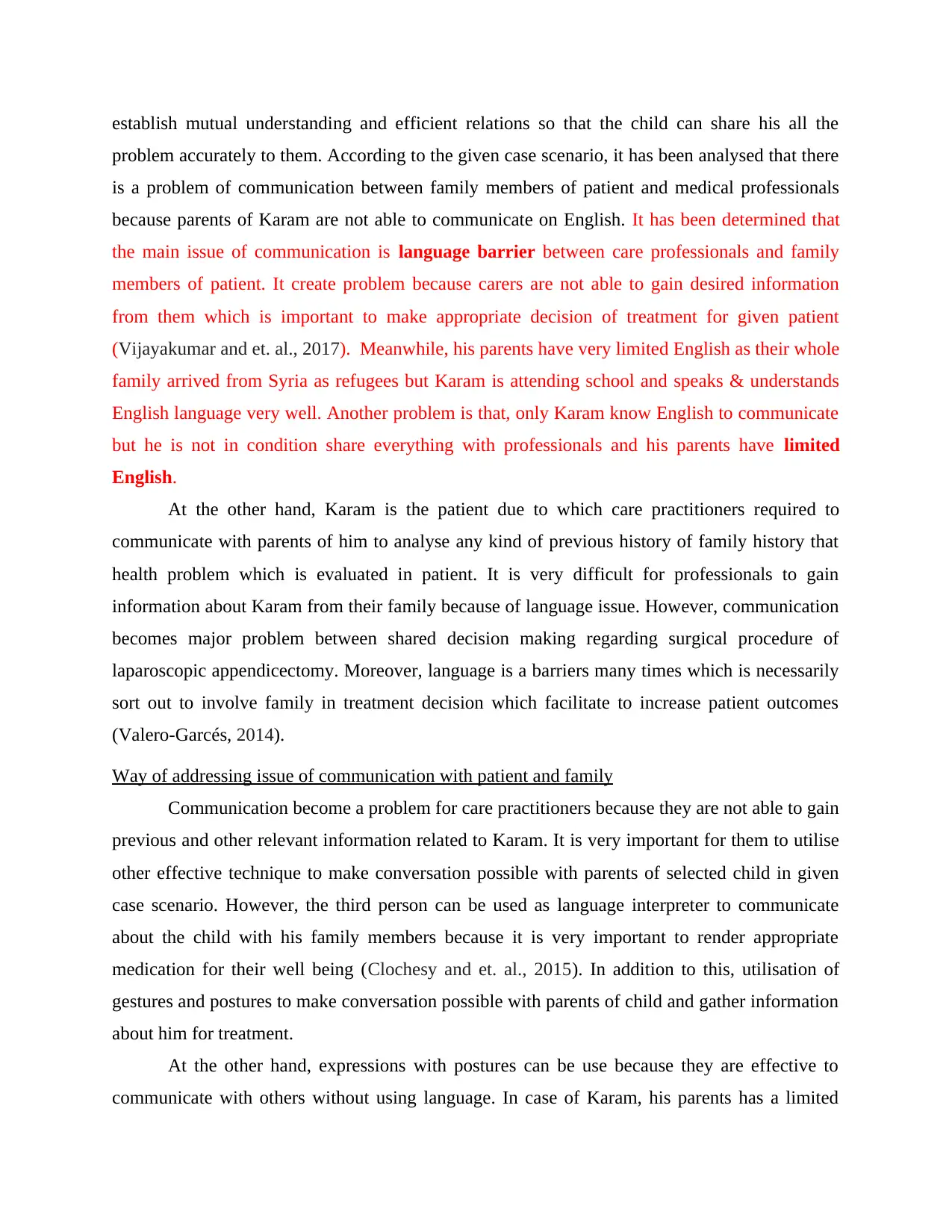
establish mutual understanding and efficient relations so that the child can share his all the
problem accurately to them. According to the given case scenario, it has been analysed that there
is a problem of communication between family members of patient and medical professionals
because parents of Karam are not able to communicate on English. It has been determined that
the main issue of communication is language barrier between care professionals and family
members of patient. It create problem because carers are not able to gain desired information
from them which is important to make appropriate decision of treatment for given patient
(Vijayakumar and et. al., 2017). Meanwhile, his parents have very limited English as their whole
family arrived from Syria as refugees but Karam is attending school and speaks & understands
English language very well. Another problem is that, only Karam know English to communicate
but he is not in condition share everything with professionals and his parents have limited
English.
At the other hand, Karam is the patient due to which care practitioners required to
communicate with parents of him to analyse any kind of previous history of family history that
health problem which is evaluated in patient. It is very difficult for professionals to gain
information about Karam from their family because of language issue. However, communication
becomes major problem between shared decision making regarding surgical procedure of
laparoscopic appendicectomy. Moreover, language is a barriers many times which is necessarily
sort out to involve family in treatment decision which facilitate to increase patient outcomes
(Valero-Garcés, 2014).
Way of addressing issue of communication with patient and family
Communication become a problem for care practitioners because they are not able to gain
previous and other relevant information related to Karam. It is very important for them to utilise
other effective technique to make conversation possible with parents of selected child in given
case scenario. However, the third person can be used as language interpreter to communicate
about the child with his family members because it is very important to render appropriate
medication for their well being (Clochesy and et. al., 2015). In addition to this, utilisation of
gestures and postures to make conversation possible with parents of child and gather information
about him for treatment.
At the other hand, expressions with postures can be use because they are effective to
communicate with others without using language. In case of Karam, his parents has a limited
problem accurately to them. According to the given case scenario, it has been analysed that there
is a problem of communication between family members of patient and medical professionals
because parents of Karam are not able to communicate on English. It has been determined that
the main issue of communication is language barrier between care professionals and family
members of patient. It create problem because carers are not able to gain desired information
from them which is important to make appropriate decision of treatment for given patient
(Vijayakumar and et. al., 2017). Meanwhile, his parents have very limited English as their whole
family arrived from Syria as refugees but Karam is attending school and speaks & understands
English language very well. Another problem is that, only Karam know English to communicate
but he is not in condition share everything with professionals and his parents have limited
English.
At the other hand, Karam is the patient due to which care practitioners required to
communicate with parents of him to analyse any kind of previous history of family history that
health problem which is evaluated in patient. It is very difficult for professionals to gain
information about Karam from their family because of language issue. However, communication
becomes major problem between shared decision making regarding surgical procedure of
laparoscopic appendicectomy. Moreover, language is a barriers many times which is necessarily
sort out to involve family in treatment decision which facilitate to increase patient outcomes
(Valero-Garcés, 2014).
Way of addressing issue of communication with patient and family
Communication become a problem for care practitioners because they are not able to gain
previous and other relevant information related to Karam. It is very important for them to utilise
other effective technique to make conversation possible with parents of selected child in given
case scenario. However, the third person can be used as language interpreter to communicate
about the child with his family members because it is very important to render appropriate
medication for their well being (Clochesy and et. al., 2015). In addition to this, utilisation of
gestures and postures to make conversation possible with parents of child and gather information
about him for treatment.
At the other hand, expressions with postures can be use because they are effective to
communicate with others without using language. In case of Karam, his parents has a limited
Paraphrase This Document
Need a fresh take? Get an instant paraphrase of this document with our AI Paraphraser
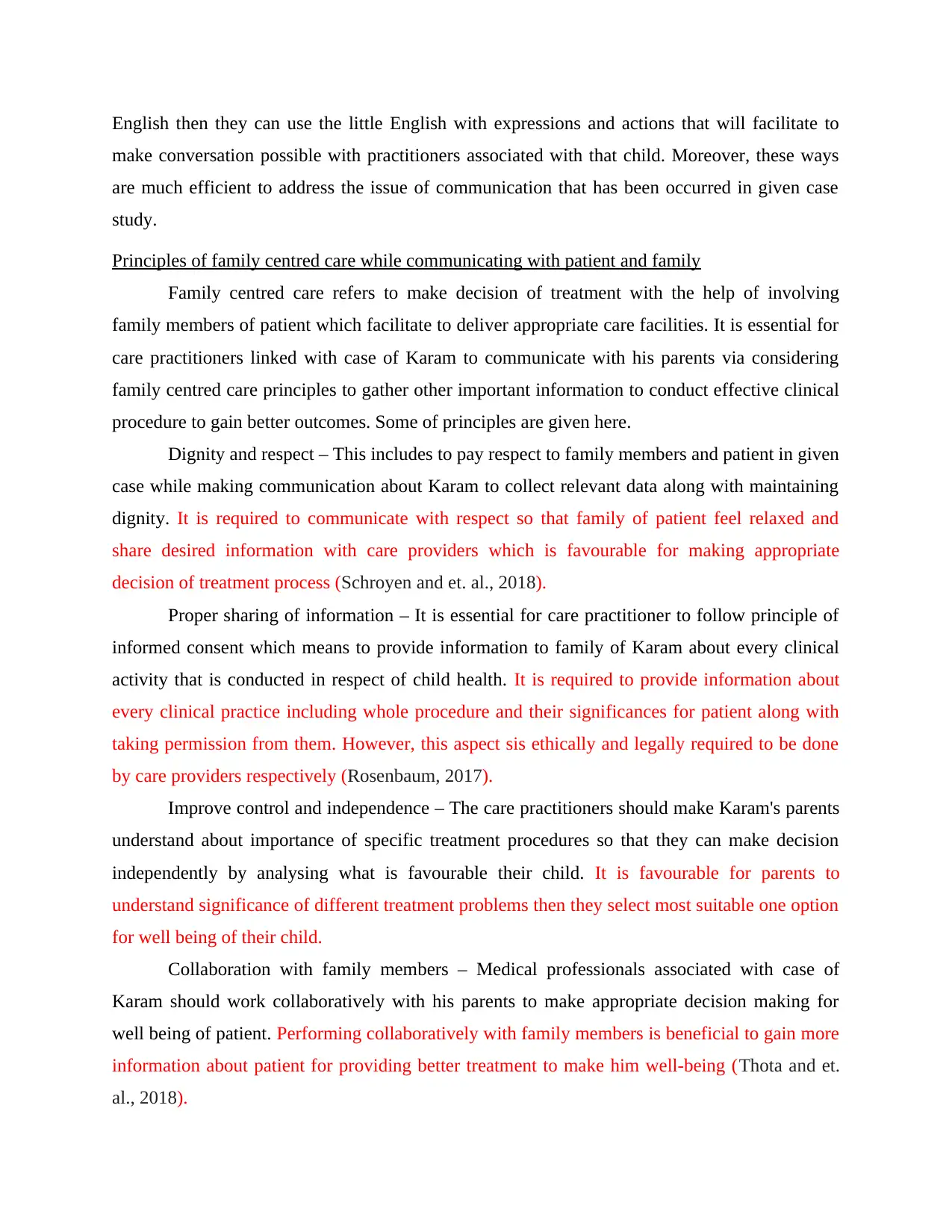
English then they can use the little English with expressions and actions that will facilitate to
make conversation possible with practitioners associated with that child. Moreover, these ways
are much efficient to address the issue of communication that has been occurred in given case
study.
Principles of family centred care while communicating with patient and family
Family centred care refers to make decision of treatment with the help of involving
family members of patient which facilitate to deliver appropriate care facilities. It is essential for
care practitioners linked with case of Karam to communicate with his parents via considering
family centred care principles to gather other important information to conduct effective clinical
procedure to gain better outcomes. Some of principles are given here.
Dignity and respect – This includes to pay respect to family members and patient in given
case while making communication about Karam to collect relevant data along with maintaining
dignity. It is required to communicate with respect so that family of patient feel relaxed and
share desired information with care providers which is favourable for making appropriate
decision of treatment process (Schroyen and et. al., 2018).
Proper sharing of information – It is essential for care practitioner to follow principle of
informed consent which means to provide information to family of Karam about every clinical
activity that is conducted in respect of child health. It is required to provide information about
every clinical practice including whole procedure and their significances for patient along with
taking permission from them. However, this aspect sis ethically and legally required to be done
by care providers respectively (Rosenbaum, 2017).
Improve control and independence – The care practitioners should make Karam's parents
understand about importance of specific treatment procedures so that they can make decision
independently by analysing what is favourable their child. It is favourable for parents to
understand significance of different treatment problems then they select most suitable one option
for well being of their child.
Collaboration with family members – Medical professionals associated with case of
Karam should work collaboratively with his parents to make appropriate decision making for
well being of patient. Performing collaboratively with family members is beneficial to gain more
information about patient for providing better treatment to make him well-being (Thota and et.
al., 2018).
make conversation possible with practitioners associated with that child. Moreover, these ways
are much efficient to address the issue of communication that has been occurred in given case
study.
Principles of family centred care while communicating with patient and family
Family centred care refers to make decision of treatment with the help of involving
family members of patient which facilitate to deliver appropriate care facilities. It is essential for
care practitioners linked with case of Karam to communicate with his parents via considering
family centred care principles to gather other important information to conduct effective clinical
procedure to gain better outcomes. Some of principles are given here.
Dignity and respect – This includes to pay respect to family members and patient in given
case while making communication about Karam to collect relevant data along with maintaining
dignity. It is required to communicate with respect so that family of patient feel relaxed and
share desired information with care providers which is favourable for making appropriate
decision of treatment process (Schroyen and et. al., 2018).
Proper sharing of information – It is essential for care practitioner to follow principle of
informed consent which means to provide information to family of Karam about every clinical
activity that is conducted in respect of child health. It is required to provide information about
every clinical practice including whole procedure and their significances for patient along with
taking permission from them. However, this aspect sis ethically and legally required to be done
by care providers respectively (Rosenbaum, 2017).
Improve control and independence – The care practitioners should make Karam's parents
understand about importance of specific treatment procedures so that they can make decision
independently by analysing what is favourable their child. It is favourable for parents to
understand significance of different treatment problems then they select most suitable one option
for well being of their child.
Collaboration with family members – Medical professionals associated with case of
Karam should work collaboratively with his parents to make appropriate decision making for
well being of patient. Performing collaboratively with family members is beneficial to gain more
information about patient for providing better treatment to make him well-being (Thota and et.
al., 2018).
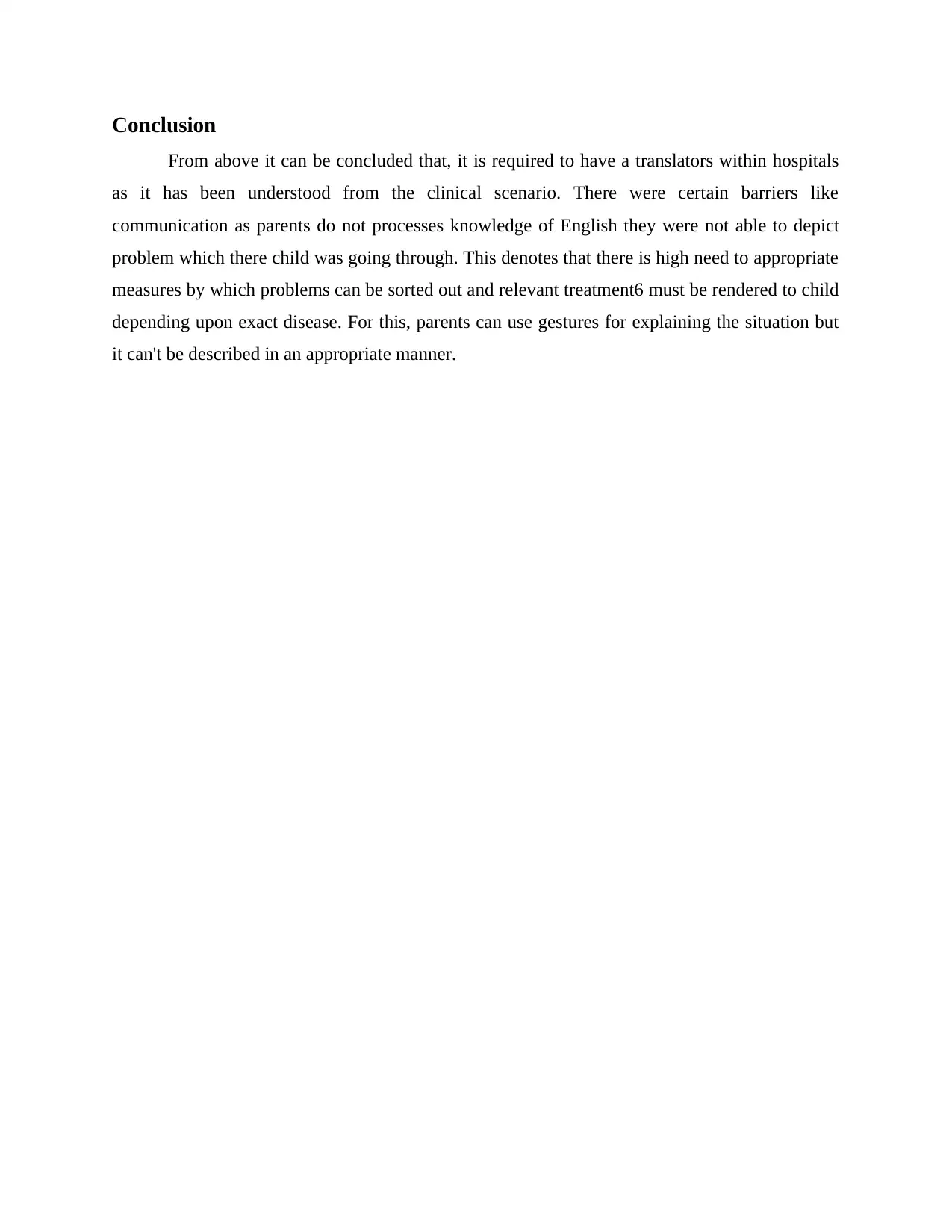
Conclusion
From above it can be concluded that, it is required to have a translators within hospitals
as it has been understood from the clinical scenario. There were certain barriers like
communication as parents do not processes knowledge of English they were not able to depict
problem which there child was going through. This denotes that there is high need to appropriate
measures by which problems can be sorted out and relevant treatment6 must be rendered to child
depending upon exact disease. For this, parents can use gestures for explaining the situation but
it can't be described in an appropriate manner.
From above it can be concluded that, it is required to have a translators within hospitals
as it has been understood from the clinical scenario. There were certain barriers like
communication as parents do not processes knowledge of English they were not able to depict
problem which there child was going through. This denotes that there is high need to appropriate
measures by which problems can be sorted out and relevant treatment6 must be rendered to child
depending upon exact disease. For this, parents can use gestures for explaining the situation but
it can't be described in an appropriate manner.
⊘ This is a preview!⊘
Do you want full access?
Subscribe today to unlock all pages.

Trusted by 1+ million students worldwide
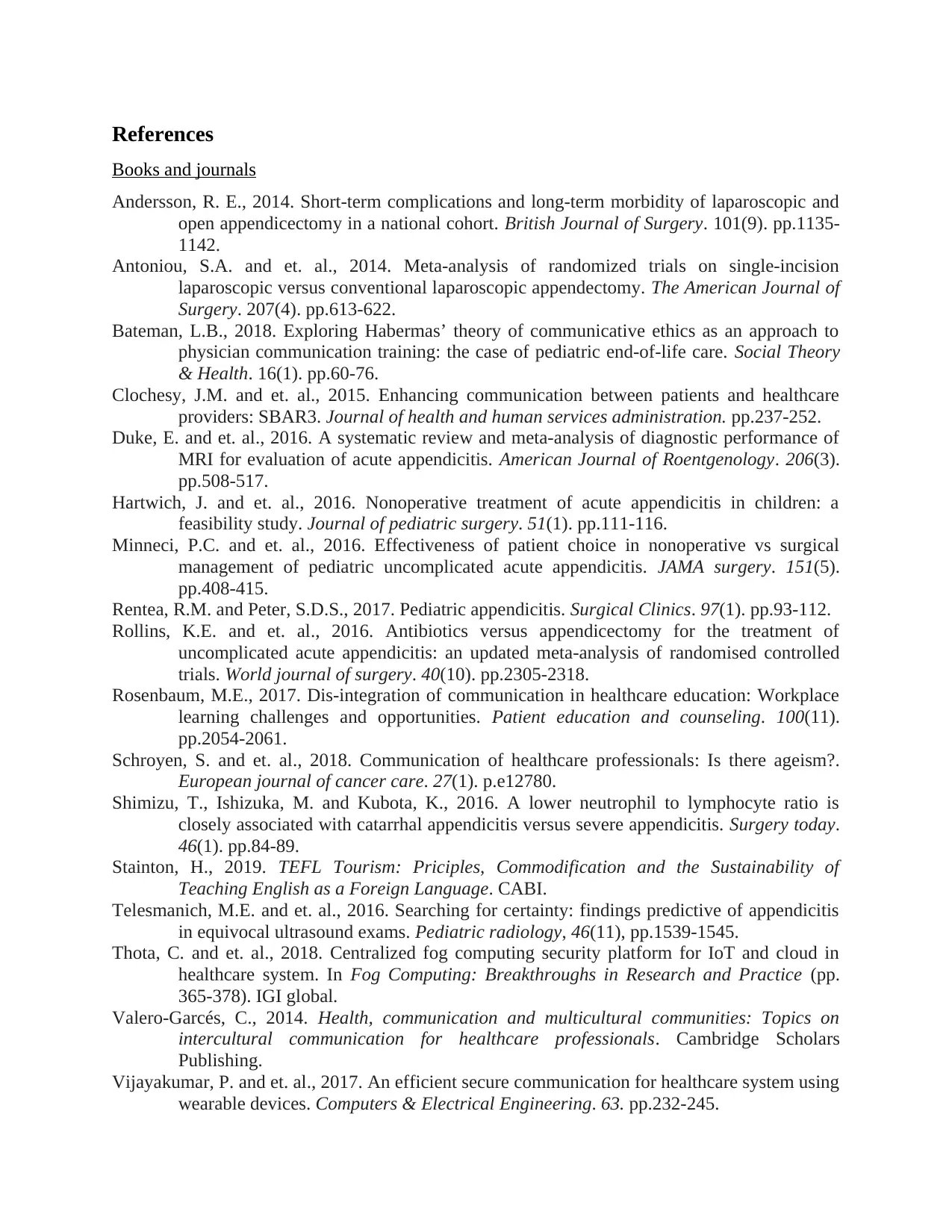
References
Books and journals
Andersson, R. E., 2014. Short‐term complications and long‐term morbidity of laparoscopic and
open appendicectomy in a national cohort. British Journal of Surgery. 101(9). pp.1135-
1142.
Antoniou, S.A. and et. al., 2014. Meta-analysis of randomized trials on single-incision
laparoscopic versus conventional laparoscopic appendectomy. The American Journal of
Surgery. 207(4). pp.613-622.
Bateman, L.B., 2018. Exploring Habermas’ theory of communicative ethics as an approach to
physician communication training: the case of pediatric end-of-life care. Social Theory
& Health. 16(1). pp.60-76.
Clochesy, J.M. and et. al., 2015. Enhancing communication between patients and healthcare
providers: SBAR3. Journal of health and human services administration. pp.237-252.
Duke, E. and et. al., 2016. A systematic review and meta-analysis of diagnostic performance of
MRI for evaluation of acute appendicitis. American Journal of Roentgenology. 206(3).
pp.508-517.
Hartwich, J. and et. al., 2016. Nonoperative treatment of acute appendicitis in children: a
feasibility study. Journal of pediatric surgery. 51(1). pp.111-116.
Minneci, P.C. and et. al., 2016. Effectiveness of patient choice in nonoperative vs surgical
management of pediatric uncomplicated acute appendicitis. JAMA surgery. 151(5).
pp.408-415.
Rentea, R.M. and Peter, S.D.S., 2017. Pediatric appendicitis. Surgical Clinics. 97(1). pp.93-112.
Rollins, K.E. and et. al., 2016. Antibiotics versus appendicectomy for the treatment of
uncomplicated acute appendicitis: an updated meta-analysis of randomised controlled
trials. World journal of surgery. 40(10). pp.2305-2318.
Rosenbaum, M.E., 2017. Dis-integration of communication in healthcare education: Workplace
learning challenges and opportunities. Patient education and counseling. 100(11).
pp.2054-2061.
Schroyen, S. and et. al., 2018. Communication of healthcare professionals: Is there ageism?.
European journal of cancer care. 27(1). p.e12780.
Shimizu, T., Ishizuka, M. and Kubota, K., 2016. A lower neutrophil to lymphocyte ratio is
closely associated with catarrhal appendicitis versus severe appendicitis. Surgery today.
46(1). pp.84-89.
Stainton, H., 2019. TEFL Tourism: Priciples, Commodification and the Sustainability of
Teaching English as a Foreign Language. CABI.
Telesmanich, M.E. and et. al., 2016. Searching for certainty: findings predictive of appendicitis
in equivocal ultrasound exams. Pediatric radiology, 46(11), pp.1539-1545.
Thota, C. and et. al., 2018. Centralized fog computing security platform for IoT and cloud in
healthcare system. In Fog Computing: Breakthroughs in Research and Practice (pp.
365-378). IGI global.
Valero-Garcés, C., 2014. Health, communication and multicultural communities: Topics on
intercultural communication for healthcare professionals. Cambridge Scholars
Publishing.
Vijayakumar, P. and et. al., 2017. An efficient secure communication for healthcare system using
wearable devices. Computers & Electrical Engineering. 63. pp.232-245.
Books and journals
Andersson, R. E., 2014. Short‐term complications and long‐term morbidity of laparoscopic and
open appendicectomy in a national cohort. British Journal of Surgery. 101(9). pp.1135-
1142.
Antoniou, S.A. and et. al., 2014. Meta-analysis of randomized trials on single-incision
laparoscopic versus conventional laparoscopic appendectomy. The American Journal of
Surgery. 207(4). pp.613-622.
Bateman, L.B., 2018. Exploring Habermas’ theory of communicative ethics as an approach to
physician communication training: the case of pediatric end-of-life care. Social Theory
& Health. 16(1). pp.60-76.
Clochesy, J.M. and et. al., 2015. Enhancing communication between patients and healthcare
providers: SBAR3. Journal of health and human services administration. pp.237-252.
Duke, E. and et. al., 2016. A systematic review and meta-analysis of diagnostic performance of
MRI for evaluation of acute appendicitis. American Journal of Roentgenology. 206(3).
pp.508-517.
Hartwich, J. and et. al., 2016. Nonoperative treatment of acute appendicitis in children: a
feasibility study. Journal of pediatric surgery. 51(1). pp.111-116.
Minneci, P.C. and et. al., 2016. Effectiveness of patient choice in nonoperative vs surgical
management of pediatric uncomplicated acute appendicitis. JAMA surgery. 151(5).
pp.408-415.
Rentea, R.M. and Peter, S.D.S., 2017. Pediatric appendicitis. Surgical Clinics. 97(1). pp.93-112.
Rollins, K.E. and et. al., 2016. Antibiotics versus appendicectomy for the treatment of
uncomplicated acute appendicitis: an updated meta-analysis of randomised controlled
trials. World journal of surgery. 40(10). pp.2305-2318.
Rosenbaum, M.E., 2017. Dis-integration of communication in healthcare education: Workplace
learning challenges and opportunities. Patient education and counseling. 100(11).
pp.2054-2061.
Schroyen, S. and et. al., 2018. Communication of healthcare professionals: Is there ageism?.
European journal of cancer care. 27(1). p.e12780.
Shimizu, T., Ishizuka, M. and Kubota, K., 2016. A lower neutrophil to lymphocyte ratio is
closely associated with catarrhal appendicitis versus severe appendicitis. Surgery today.
46(1). pp.84-89.
Stainton, H., 2019. TEFL Tourism: Priciples, Commodification and the Sustainability of
Teaching English as a Foreign Language. CABI.
Telesmanich, M.E. and et. al., 2016. Searching for certainty: findings predictive of appendicitis
in equivocal ultrasound exams. Pediatric radiology, 46(11), pp.1539-1545.
Thota, C. and et. al., 2018. Centralized fog computing security platform for IoT and cloud in
healthcare system. In Fog Computing: Breakthroughs in Research and Practice (pp.
365-378). IGI global.
Valero-Garcés, C., 2014. Health, communication and multicultural communities: Topics on
intercultural communication for healthcare professionals. Cambridge Scholars
Publishing.
Vijayakumar, P. and et. al., 2017. An efficient secure communication for healthcare system using
wearable devices. Computers & Electrical Engineering. 63. pp.232-245.
1 out of 10
Related Documents
Your All-in-One AI-Powered Toolkit for Academic Success.
+13062052269
info@desklib.com
Available 24*7 on WhatsApp / Email
![[object Object]](/_next/static/media/star-bottom.7253800d.svg)
Unlock your academic potential
Copyright © 2020–2025 A2Z Services. All Rights Reserved. Developed and managed by ZUCOL.





